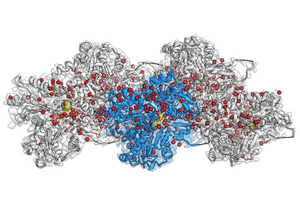Image: Cryo-EM reconstruction of F-actin bound to Mg2+-ADP-BeF3. at 2.2 Å resolution. The central actin subunit is colored blue, the other four subunits are grey. Densities corresponding to water molecules are colored red and ADP yellow.
outlook more
Photo credit: MPI for Molecular Physiology
“We answer fundamental questions of life that scientists have been trying to answer for several decades,” says Raunser. In eukaryotic cells, actin proteins are abundant and tend to associate (polymerize) into filaments. These filaments form the network that makes up the cell’s cytoskeleton and controls various cell processes through movement. Immune cells, for example, use actin filaments to move and hunt bacteria and viruses. The researchers already knew that the dynamics of the filaments are regulated by ATP hydrolysis – the reaction of ATP with water, which cleaves a phosphate group and generates energy. However, what has remained unanswered so far are the precise molecular details behind this process.
Too flexible, too big? – not for cryo-EM
Because actin filaments are too flexible or too large for X-ray crystallization and nuclear magnetic resonance, cryo-EM was the only technique capable of obtaining detailed images. In 2015, Raunser’s team used cryo-EM to image a novel three-dimensional atomic model of the filaments with a resolution of 0.37 nanometers. In 2018, his group described the three different states actin proteins assume in the filament: bound to ATP, bound to ADP in the presence of the cleaved phosphate, bound to ADP after the phosphate is released.
How water molecules move
In their current study, Raunser and his colleagues were able to set a new resolution record: They obtained all three actin states with a resolution of around 0.2 nanometers and made previously invisible details visible. The three-dimensional maps not only show all the amino acid side chains of the proteins, but also show where hundreds of water molecules are placed. By comparing these new structures to those of isolated actin, they were able to deduce how water molecules move. During polymerization, water molecules in the ATP pocket shift in such a way that only a single water molecule remains in front of ATP, ready to attack a phosphate and initiate hydrolysis. The accuracy achieved through this approach can help further research in this field: “Our high-resolution model can advance scientists in the design of small molecules for light microscopic tissue research and ultimately for therapeutic applications,” says Raunser.
A door opener!?
The authors also shed light on the ultimate fate of the phosphate. Previously, scientists believed that there is a back door in the ATP pocket that remains open after ATP hydrolysis to facilitate the phosphate exit. However, the new cryo-EM structures show no trace of open backdoors. Therefore, the release mechanism remains a mystery. “We believe that there is a door, but it probably opens for a moment,” says Raunser, who now wants to show how the phosphate escapes using mathematical simulations and time-resolved cryo-EM methods. Apparently, these exciting discoveries have opened the door for scientists to dig deeper in hopes of uncovering even more details behind the processes by which actin filaments contribute to cell movement.
research method
Experimental study
subject of research
cells
article title
Structural principles of the formation and aging of actin filaments
Article publication date
October 26, 2022
Disclaimer: AAAS and EurekAlert! are not responsible for the accuracy of the press releases published on EurekAlert! by contributing institutions or for the use of information about the EurekAlert system.
#pocket #full #water #molecules #actin #filaments #drive #movement #cell


Leave a Comment